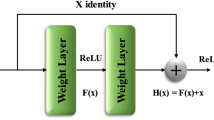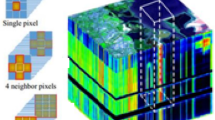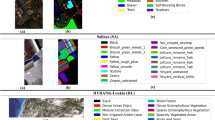Abstract
Remote sensing image analysis is an emerging area of research and is used for various applications such as climate analysis, crop monitoring and change detection. Hyperspectral image (HSI) is one of the dominant remote sensing imaging modalities that captures information beyond the visible spectrum. The evolution of deep learning has made a significant impact on HSI analysis, mainly for its classification. The spatial–spectral feature-based classification model improves the classification accuracy of hyperspectral images (HSIs). However, these models are computationally expensive, and redundancy exists in the spatial dimension of features. This research work proposes a hybrid convolutional neural network (CNN) for HSI classification. The proposed model uses principal component analysis (PCA) as a preprocessing technique for optimal band extraction from HSIs. The hybrid CNN classification technique extracts the spectral and spatial features using three-dimensional CNN (3D CNN). These features are fed into a two-dimensional CNN (2D CNN) for further feature extraction and classification. The redundancy in spatial features of the hybrid CNN model is reduced by octave convolution (OctConv) instead of standard vanilla convolution. OctConv factorizes the spatial features into lower and higher spatial frequencies, and different convolutions are performed on them based on their frequencies. The hybrid model is compared against various state-of-the-art CNN-based techniques and found that the accuracy is boosted with a lesser computational cost.





Similar content being viewed by others
References
Camps-Valls, G., Gómez-Chova, L., Muñoz, J., Vila-Francés, J., Calpe, J.: Composite kernels for hyperspectral image classification. Geosci. Remote Sens. Lett. IEEE 3, 93–97 (2006). https://doi.org/10.1109/LGRS.2005.857031
Chen, C., Jiang, F., Yang, C., Rho, S., Shen, W., Liu, S., Liu, Z.: Hyperspectral classification based on spectral–spatial convolutional neural networks. Eng. Appl. Artif. Intell. 68, 165–171 (2018). https://doi.org/10.1016/j.engappai.2017.10.015
Chen, Y., Fang, H., Xu, B., Yan, Z., Kalantidis, Y., Rohrbach, M., Yan, S., Feng, J.: Drop an octave: reducing spatial redundancy in convolutional neural networks with octave convolution. arXiv preprint. arXiv:1904.05049 (2019)
Chen, Y., Jiang, H., Li, C., Jia, X., Ghamisi, P.: Deep feature extraction and classification of hyperspectral images based on convolutional neural networks. IEEE Trans. Geosci. Remote Sens. 54(10), 6232–6251 (2016). https://doi.org/10.1109/TGRS.2016.2584107
Chen, Y., Lin, Z., Zhao, X., Member, S., Wang, G., Gu, Y.: Deep learning-based classification of hyperspectral data. IEEE J. Sel. Top. Appl. Earth Observ. Remote Sens. 7(6), 2094–2107 (2014). https://doi.org/10.1109/JSTARS.2014.2329330
Congalton, R., Green, K.: Assessing the Accuracy of Remotely Sensed Data: Principles and Practices, 3rd edn. CRC Press, Boca Raton (2019). https://doi.org/10.1201/9780429052729
Fauvel, M., Chanussot, J., Benediktsson, J.A.: A spatial-spectral kernel-based approach for the classification of remote-sensing images. Pattern Recogn. 45(1), 381–392 (2012). https://doi.org/10.1016/j.patcog.2011.03.035
Gao, H., Yao, D., Wang, M., Li, C., Liu, H., Hua, Z., Wang, J.: A hyperspectral image classification method based on multi-discriminator generative adversarial networks. Sensors 19(15), 3269 (2019). https://doi.org/10.3390/s19153269
Ham, J., Chen, Yangchi, Crawford, M.M., Ghosh, J.: Investigation of the random forest framework for classification of hyperspectral data. IEEE Trans Geosci Remote Sens 43(3), 492–501 (2005). https://doi.org/10.1109/TGRS.2004.842481
Hang, R., Liu, Q., Hong, D., Ghamisi, P.: Cascaded recurrent neural networks for hyperspectral image classification. IEEE Trans. Geosci. Remote Sens. 57(8), 1 (2019). https://doi.org/10.1109/TGRS.2019.2899129
Haut, J.M., Paoletti, M.E., Plaza, J., Li, J., Plaza, A.: Active learning with convolutional neural networks for hyperspectral image classification using a new bayesian approach. IEEE Trans. Geosci. Remote Sens. 56(11), 6440–6461 (2018). https://doi.org/10.1109/TGRS.2018.2838665
He, K., Zhang, X., Ren, S., Sun, J.: Deep residual learning for image recognition. In: 2016 IEEE Conference on Computer Vision and Pattern Recognition (CVPR) pp. 770–778 (2015)
Hu, W.S., Li, H.C., Member, S., Pan, L., Li, W., Member, S.: Feature Extraction and Classification Based on Spatial-Spectral ConvLSTM Neural Network for Hyperspectral Images. In: IEEE Transactions on Geoscience and Remote Sensing, pp. 1–15 (2019)
Jensen, J.: Remote Sensing of the Environment: An Earth Resource Perspective, 2nd edn. Prentice Hall, Upper Saddle River (2007)
Krizhevsky, A., Sutskever, I., Hinton, G.E.: Imagenet classification with deep convolutional neural networks. In: Advances in Neural Information Processing Systems, vol. 25, pp. 1097–1105. Curran Associates, Inc., New York (2012)
Lee, H., Kwon, H.: Going deeper with contextual CNN for hyperspectral image classification. IEEE Trans. Image Process. 26(10), 4843–4855 (2017). https://doi.org/10.1109/TIP.2017.2725580
Li, J., Xi, B., Li, Y., Du, Q., Wang, K.: Hyperspectral classification based on texture feature enhancement and deep belief networks. Remote Sens. 10(3), 396 (2018). https://doi.org/10.3390/rs10030396
Ma, A., Filippi, A.M., Wang, Z., Yin, Z.: Hyperspectral image classification using similarity measurements-based deep recurrent neural networks. Remote Sens. 11(2), 1–19 (2019). https://doi.org/10.3390/rs11020194
Ma, X., Fu, A., Wang, J., Wang, H., Yin, B.: Hyperspectral image classification based on deep deconvolution network with skip architecture. IEEE Trans. Geosci. Remote Sens. 56(8), 4781–4791 (2018). https://doi.org/10.1109/TGRS.2018.2837142
Ma, X., Geng, J., Wang, H.: Hyperspectral image classification via contextual deep learning. Eurasip J. Image Video Process. 1, 20 (2015). https://doi.org/10.1186/s13640-015-0071-8
Mei, S., Ji, J., Geng, Y., Zhang, Z., Li, X., Du, Q.: Unsupervised spatial-spectral feature learning by 3D convolutional autoencoder for hyperspectral classification. IEEE Trans. Geosci. Remote Sens. 57(9), 6808–6820 (2019). https://doi.org/10.1109/TGRS.2019.2908756
Melgani, F., Bruzzone, L.: Classification of hyperspectral remote sensing images with support vector machines. IEEE Trans. Geosci. Remote Sens. 42, 1778–1790 (2004). https://doi.org/10.1109/TGRS.2004.831865
Mughees, A., Ali, A., Tao, L.: Hyperspectral image classification via shape-adaptive deep learning. In: 2017 IEEE International Conference on Image Processing (ICIP), pp. 375–379 (2017)
Pan, B., Shi, Z., Xu, X.: MugNet: deep learning for hyperspectral image classification using limited samples. ISPRS J. Photogramm. Remote Sens. (2017). https://doi.org/10.1016/j.isprsjprs.2017.11.003
Paoletti, M.E., Haut, J.M., Fernandez-Beltran, R., Plaza, J., Plaza, A., Li, J., Pla, F.: Capsule networks for hyperspectral image classification. IEEE Trans. Geosci. Remote Sens. 57(4), 2145–2160 (2019). https://doi.org/10.1109/TGRS.2018.2871782
Paoletti, M.E., Haut, J.M., Fernandez-Beltran, R., Plaza, J., Plaza, A.J., Pla, F.: Deep pyramidal residual networks for spectral-spatial hyperspectral image classification. IEEE Trans. Geosci. Remote Sens. 57(2), 740–754 (2019). https://doi.org/10.1109/TGRS.2018.2860125
Rodarmel, C., Shan, J.: Principal component analysis for hyperspectral image classification. Surv. Land Inf. Syst. 62, 115–122 (2002)
Roy, S.K., Krishna, G., Dubey, S.R., B Chaudhuri, B.: HybridSN : Exploring 3D-2D CNN feature hierarchy for hyperspectral image classification. In: IEEE Geoscience and Remote Sensing Letters (2019)
Shi, C., Pun, C.M.: Multi-scale hierarchical recurrent neural networks for hyperspectral image classification. Neurocomputing 294, 82–93 (2018). https://doi.org/10.1016/j.neucom.2018.03.012
Simonyan, K., Zisserman, A.: Very deep convolutional networks for large-scale image recognition. CoRR. arXiv:1409.1556 (2014)
Tarabalka, Y., Fauvel, M., Chanussot, J., Benediktsson, J.: Svm- and mrf-based method for accurate classification of hyperspectral images. Geosci. Remote Sens. Lett. IEEE 7, 736–740 (2010). https://doi.org/10.1109/LGRS.2010.2047711
Xu, Y., Member, S., Zhang, L., Member, S., Du, B., Member, S., Zhang, F.: Spectral–spatial unified networks for hyperspectral image classification. IEEE Trans. Geosci. Remote Sens. 56(10), 5893–5909 (2018). https://doi.org/10.1109/TGRS.2018.2827407
Yu, S., Jia, S., Xu, C.: Convolutional neural networks for hyperspectral image classification. Neurocomputing 219, 88–98 (2017). https://doi.org/10.1016/j.neucom.2016.09.010
Zhong, Z., Li, J., Clausi, D.A., Wong, A.: Generative adversarial networks and conditional random fields for hyperspectral image classification. In: IEEE Transactions on Cybernetics, pp. 1–12 (2019). https://doi.org/10.1109/tcyb.2019.2915094
Zhong, Z., Li, J., Luo, Z., Chapman, M.: Spectral–spatial residual network for hyperspectral image classification: a 3-d deep learning framework. IEEE Trans. Geosci. Remote Sens. 56(2), 847–858 (2018). https://doi.org/10.1109/TGRS.2017.2755542
Zhou, F., Hang, R., Liu, Q., Yuan, X.: Hyperspectral image classification using spectral-spatial LSTMs. Neurocomputing 328, 39–47 (2019). https://doi.org/10.1016/j.neucom.2018.02.105
Zhu, J., Hu, J., Jia, S., Jia, X., Li, Q.: Multiple 3-D feature fusion framework for hyperspectral image classification. IEEE Trans. Geosci. Remote Sens. 56(4), 1873–1886 (2018). https://doi.org/10.1109/TGRS.2017.2769113
Author information
Authors and Affiliations
Corresponding author
Ethics declarations
Conflict of interest
The authors declare no potential conflict of interests.
Additional information
Publisher's Note
Springer Nature remains neutral with regard to jurisdictional claims in published maps and institutional affiliations.
Rights and permissions
About this article
Cite this article
Mohan, A., Meenakshi Sundaram, V. V3O2: hybrid deep learning model for hyperspectral image classification using vanilla-3D and octave-2D convolution. J Real-Time Image Proc 18, 1681–1695 (2021). https://doi.org/10.1007/s11554-020-00966-z
Received:
Accepted:
Published:
Issue Date:
DOI: https://doi.org/10.1007/s11554-020-00966-z




